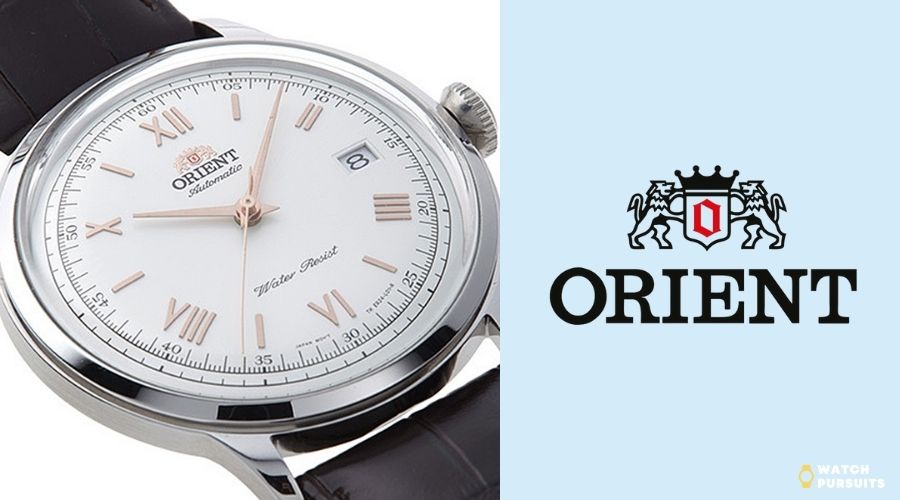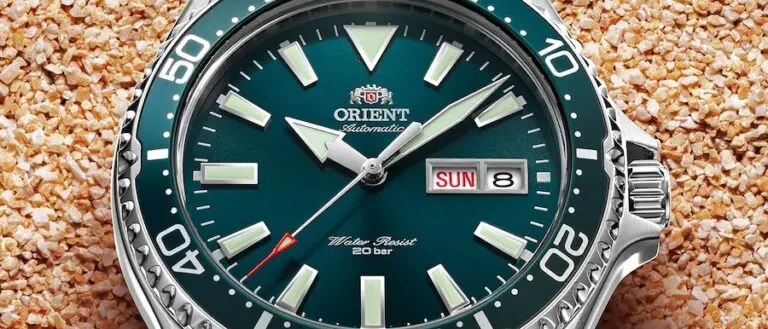Orient watches are one of those hidden gems in the world of horology. Orient watches are well made, keep time well, and most importantly, very affordable for their quality. Why are Orient watches so cheap?
Orient watches are cheap because of streamlined, in-house manufacturing that lowers production costs. Orient also uses materials creatively for their watch parts. Finally, it spends little on marketing, preferring to pass the savings to customers by selling its watches cheaper.

In this article, we will look in detail at how Orient can provide watches of high quality yet able to keep the prices low compared to their Swiss counterparts.
We have also discussed similar questions on Citizen and Longines, so feel free to check them out if you are keen.
Why Are Orient Watches Affordable?
Orient keeps its watches affordable by improving its manufacturing to the point that the production costs are low. They also further reduce costs by using materials creatively and using only word-of-mouth marketing instead of sponsoring celebrities or placing ads on media.
In-house Production
Orient is one of the few watchmakers that declares that they manufacture their watch in-house.
When your manufacturing is done in-house, you have complete control of the process, meaning multiple opportunities to increase efficiency and reduce wastage.
For example, you can relocate workshops that manufacture different watch parts and place them near the assembly plant.
This saves time and transport costs as watch parts can be quickly sent into the assembly plant. If there are defects in the parts, the assembly plant can also send the parts back to the workshops quickly to rectify.
Compare that to if your third-party contractor is 500KMs away, and parts sent out need at least 1-2 days to arrive.
These optimizations allow Orient to lower their production costs, eventually allowing them to sell their watches cheaper and still turn a profit.

Low-Cost Manufacturing
Orient is also in a strategic position to manufacture its watches in labor markets that are lower in cost.
Orient did not mention this specifically on their website (like many other watchmakers). Still, Orient has manufacturing facilities outside of Japan, in countries such as Singapore, China, Brazil, and Hong Kong.
China and Brazil have a more affordable wage rates than Japan. This means Orient can further reduce production costs as they do not have to pay high wages. They also provide job and training opportunities to people from these countries.
Plus, Japan’s Law allows a product to be labeled as ‘Made In Japan,’ even if the product is produced outside of Japan. The only requirement is that the product was produced under the supervision of a Japanese national.
That means an Orient watch can be entirely manufactured in China but still keep the ‘Made In Japan’ label, as long as the factory supervisor is Japanese.
However, Orient’s premium watch collection, the Orient Star, is made in Japan. Orient takes an approach similar to Seiko to produce lower-priced models overseas while keeping the premium models in Japanese plants.
Low Marketing Spending
Orient also does not spend a large amount of money marketing its watches.
This is in contrast to many luxury watch brands. Luxury watch brands need to continuously build and retain their brand image of class, prestige, exclusivity, and luxury.
They usually do this by sponsoring events and people who exude similar qualities. You see Rolex sponsoring many tennis and golf tournaments while Omega sponsors the Olympics.
Luxury watch brands also run many ads in publications and media to achieve the same effect. Flip through the Wall Street Journal or The Economist, and you will see ads from luxury watch companies.
Orient does not do this. In fact, you rarely see Orient placing ads or running any major marketing campaigns to promote their watches.
Instead, they focus on producing great mechanical watches, selling them at an affordable price, and working to provide their customers with an outstanding ownership experience.
Satisfied customers would then recommend Orient watches to others, which eventually becomes a source of free marketing for Orient.
Word-of-mouth marketing may be hard to do and run, but it provides the best ROI. Orient is banking on this, and you can see how well it has turned out.
Creative Use Of Materials
Orient can also keep its watch prices low by using materials creatively for their watch parts.
For example, instead of providing sapphire crystals with an anti-reflective coating on all their watches, they put in mineral crystals instead.
Perhaps the rationale is that ordinary people might not know the difference between mineral and sapphire crystal, but they can see the cheaper price tag.
Plus, substituting sapphire with mineral crystals does not affect the external appearance of the watch. It still looks well designed and great on the wrist.
Orient also applies the same approach to their bracelets.
Again, people who do not know much about watches would not care too much about solid or hollow end links on a bracelet. They might also care little if the bracelet comes with a simple or a butterfly clasp.
If you notice, these parts are user-changeable. An Orient watch owner can go to a watchmaker and request to change the bracelets or put in a sapphire crystal. That’s if they want it.
However, Orient does not skimp on the crucial bits of their watches, for example, dials and movements. There are no ‘creative substitutions’ here, just great, legendary Orient in-house movements and well-designed and made dials.
Is an Orient Watch Worth Buying?
Orient watches are worth buying as they are built in-house with reliable and robust movements. Orient watches also carry a classic look and is priced very competitively. If you appreciate classically designed watches with good history and in-house movement, Orient is your choice.
Orient is one of the few watchmakers that publicly claim to make their watches in-house. They also have a long history. Despite many watch companies pivoting to producing quartz watches during the Quartz Crisis in the 1970-the 80s, Orient maintained its tradition of making only automatic watches.
Orient also embarked on a low-cost marketing strategy, relying on producing great watches that their customer will then recommend to others. Word-of-mouth marketing is practically free. Hence Orient can save money on marketing and pass the savings down to their customer through a lower price tag.

Is Orient Watch Accurate?
Orient watches are accurate up to ±15 seconds a day, provided that you care for them. Automatic watches can have their accuracy affected by things such as shock, magnetism, lack of service, or just general neglect.
Orient’s in-house automatic movements are known for their reliability, accuracy, and robustness. For example, the caliber F6922 used in the Orient Kamasu is as accurate as ±15 seconds a day, which is good for a traditional automatic watch.
There are automatic watch movements that can do better. For example, Rolex’s automatic movements are COSC certified, which means they are accurate to -4/+6 seconds a day.
But do keep in mind the price of a Rolex compared to an Orient. Comparing them head to head like this might not be fair.
Another thing about automatic movements is that their accuracy can be affected when the watch is exposed to shock, which may disrupt the natural beating of the spring. If the watch’s hairsprings become magnetized, the watch may run faster than it should and gain time.
General neglect or lack of service may also cause the grease and oil inside the movements to dry up and generate friction that may wear down gears, reducing timekeeping accuracy.
Does Orient Make Their Own Movements?
Orient watches make their watch movements in-house, and they work independently. Despite being under the same Seiko group, they do not share any watch movements or parts with Seiko.
When watch companies join a watch group, they often share technologies and expertise with one another, resulting in changes in their watch models.
For example, watch companies under the Swatch group such as Hamilton, Tissot, Omega, and Certina all share similar movements from ETA, modified to suit their models.
Orient, however, did not take that approach despite being in the same watch group as Seiko. Orient continues to produce, develop and improve their watch movements when they can quickly adopt one of Seiko’s movements for their watches.
This is a testament to Orient’s commitment to their watches and something even watch snobs will have to approve of.
